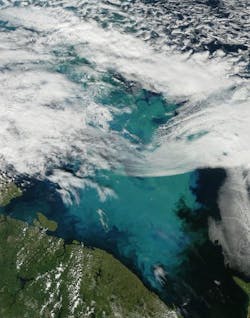As water conditions change with the seasons, different organisms tend to dominate particular regions. Satellite imagery instruments are now being used to study these transitional moments, capturing the beautiful scenes with the help of moderate resolution imaging spectroradiometers (MODIS). The instruments, built into NASA’s Aqua and Terra satellites, recently captured microscopic, plant-like organisms, known as phytoplankton, blooming in the waters off of Norway and Russia.
MODIS captures images using the 1000-m, 500-m, and 250-m resolution spectral bands with 12-bit radiometric sensitivity. Spectral bands ranging from 0.4 to 14.4 μm are custom-tailored to handle low out-of-band responses. Each scan undergoes infrared (IR) calibration to reduce 1/f noise and boost accuracy. A ±55-degree scanning pattern achieves a 2330-km swatch, providing global coverage every one to two days.
An on-board spectroradiometric calibration assembly (SRCA) and full-aperture blackbody (BB) help foster MODIS precision functionality. The SRCA monitors the visible (VIS), near IR (NIR), and short-wave infrared (SWIR) bands on the MODIS. It can also generate band-to-band registration information while in orbit for all 36 spectral bands. Using a variety of optics and mechanisms, input stimuli can be modified in three modes—spectral, radiometric, and spatial—without interfering with other sensors. As a result, the SRCA can generate calibration information while the MODIS simultaneously collects and records spectral data, allowing for longer stretches of continual data.
The BB, tasked with thermal-band calibration, makes it possible to determine photon temperature simply by viewing them in the far IR, or mid- and long-wave IR bands. On top of that, the BB’s assembly provides a full-aperture radiometric calibration source for the mid-wave IR (MWIR) and long-wave infrared (LWIR) bands to within 1% accuracy. A proprietary process used to create the device’s non-reflective, black surface minimizes scatter and ensures effective cavity emissivity. Twelve sensors below its surface monitor its temperature to retain precise measurements.
In addition to the MODIS, the Aqua and Terra satellites both house a CERES instrument that’s similar to the one used in the JPSS-1 weather satellite (see “UPDATE: JPSS-1 Weather Satellite Boosts Forecasting Accuracy” at Microwaves & RF). The satellites are part of the international, NASA-centered Earth Observing System (EOS). EOS is a coordinated series of polar-orbiting and low inclination satellites that gather long-term, global observations regarding the land surface, biosphere, solid Earth, atmosphere, and oceans.


